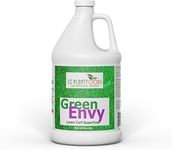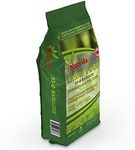Buying Guide for the Best Weed Feed Fertilizer
Choosing the right weed-feed-fertilizer for your lawn or garden can make a big difference in the health and appearance of your grass and plants. The best product for you depends on your specific needs, such as the type of weeds you want to control, the kind of grass or plants you have, and the time of year you plan to apply it. Understanding the key features and how they relate to your situation will help you make a smart choice and get the best results.Weed Control TypeWeed control type refers to whether the product targets broadleaf weeds, grassy weeds, or both. This is important because different weeds require different treatments. Some products are selective, meaning they only kill certain types of weeds without harming your grass, while others are non-selective and will kill most plants they touch. If your lawn is mostly affected by dandelions and clover, a broadleaf weed control is best. If you have issues with crabgrass or other grassy weeds, look for a product that targets those. Always match the weed control type to the weeds you see in your yard for the best results.
Fertilizer Composition (N-P-K Ratio)The N-P-K ratio stands for Nitrogen (N), Phosphorus (P), and Potassium (K), which are the main nutrients in fertilizers. This ratio is important because it tells you what nutrients your lawn will receive. High nitrogen promotes green growth, phosphorus supports root development, and potassium helps with overall health and disease resistance. For lush, green lawns, a higher nitrogen content is often preferred. If you’re establishing new grass or want to strengthen roots, look for more phosphorus. For general maintenance, a balanced ratio works well. Consider your lawn’s needs and the season—spring usually calls for more nitrogen, while fall may need more potassium.
Application TimingApplication timing refers to when the product should be applied for the best effect. This is important because applying at the wrong time can reduce effectiveness or even harm your lawn. Some weed-feed-fertilizers are designed for spring use to prevent weeds before they sprout, while others are for summer or fall to feed the lawn and control existing weeds. Check the product instructions and match the timing to your lawn’s growth cycle and the types of weeds you want to control. If you’re unsure, early spring and early fall are common times for application.
Coverage AreaCoverage area tells you how much lawn or garden space the product will treat. This is important to ensure you buy enough product for your needs without wasting money or under-treating your yard. Coverage is usually listed in square feet or meters. Measure your lawn before buying and choose a product that matches or slightly exceeds your area. If you have a small yard, a smaller package is fine, but for large lawns, look for larger or multiple packages.
Formulation (Granular vs. Liquid)Formulation refers to whether the product comes as granules or a liquid. This matters because it affects how you apply the product and how quickly it works. Granular products are spread with a spreader and are easy for most homeowners to use, releasing nutrients and weed control slowly. Liquid products are sprayed and can act faster, but may require more careful application. If you want convenience and slow, steady feeding, go with granules. If you need quick results or have experience with sprayers, liquid might be better. Choose based on your comfort with application and how quickly you want to see results.










